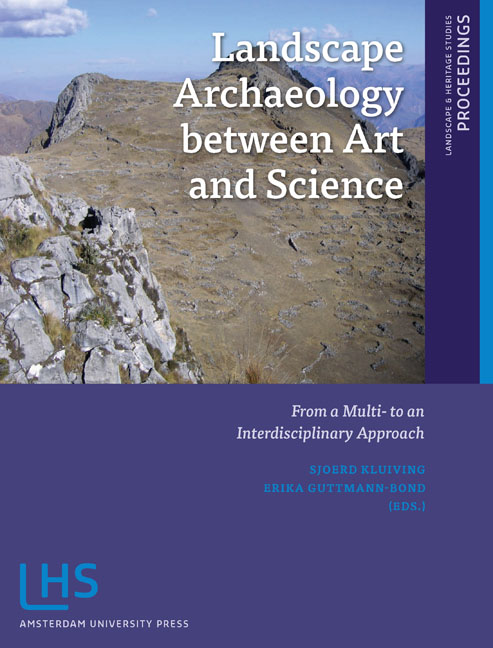Book contents
- Frontmatter
- Contents
- Preface
- Introduction: LAC2010: First International Landscape Archaeology Conference
- THEME 1 HOW DID LANDSCAPE CHANGE?
- THEME II IMPROVING TEMPORAL, CHRONOLOGICAL AND TRANSFORMATIONAL FRAMEWORKS
- THEME III LINKING LANDSCAPES OF LOWLANDS TO MOUNTAINOUS AREAS
- THEME IV APPLYING CONCEPTS OF SCALE
- THEME V NEW DIRECTIONS IN DIGITAL PROSPECTION AND MODELLING TECHNIQUES
- THEME VI HOW WILL LANDSCAPE ARCHAEOLOGY DEVELOP IN THE FUTURE?
- Miscellaneous Endmatter
1.8 - Configuring the Landscape: Roman Mining in the Conventus Asturum (NW Hispania)
Published online by Cambridge University Press: 21 January 2021
- Frontmatter
- Contents
- Preface
- Introduction: LAC2010: First International Landscape Archaeology Conference
- THEME 1 HOW DID LANDSCAPE CHANGE?
- THEME II IMPROVING TEMPORAL, CHRONOLOGICAL AND TRANSFORMATIONAL FRAMEWORKS
- THEME III LINKING LANDSCAPES OF LOWLANDS TO MOUNTAINOUS AREAS
- THEME IV APPLYING CONCEPTS OF SCALE
- THEME V NEW DIRECTIONS IN DIGITAL PROSPECTION AND MODELLING TECHNIQUES
- THEME VI HOW WILL LANDSCAPE ARCHAEOLOGY DEVELOP IN THE FUTURE?
- Miscellaneous Endmatter
Summary
ABSTRACT
The Conventus Iuridicus Asturum (mainly, though not only, modern Asturias and León provinces in Spain) was created after the Cantabrian Wars carried out by Augustus himself, which finished in 19 BC. Even though the NW quadrant of the Iberian Peninsula was rich in gold, the C. Asturum concentrated the greatest deposits in the western ends of both Asturias and León. The exploitation of gold was a strategic need for Augustus’ new Imperial coin, the aureus. Those areas with rich pre-Roman goldwork were systematically prospected and mined during the first two centuries of the Christian Era. As a consequence, local populations were subjected to a special form of imperialist policy directed at ensuring the maximum output of minerals. Settlement form and function was radically changed and a tributary system was put in place, thereby changing local society completely.
This policy had a major effect on the landscape in two ways: the mines brought about important geomorphological changes, and the territorial policy changed the rural exploitation of the area with a new landscape management and an increasing importance of cereal cultivation. In this paper these changes are brought forth as what they are: a measure of the impact that Roman gold mining had on the landscape.
KEYWORDS
Roman gold mining; geomorphology; palaeoenvironment; pollen analysis; rural exploitation
GEOMORPHOLOGICAL TRANSFORMATIONS AND FOREST EVOLUTION
In 19 BC the Cantabrian Wars ended. At that moment Roman Asturia was configured as the Conventus Iuridicus Asturum (see Figure 1), thereby becoming incorporated into the Empire. In that area gold had already been exploited at the artisan level (Fernández-Posse de Arnáiz et al. 2004; Sánchez-Palencia Ramos & Fernández-Posse de Arnáiz 1998), generating a rich catalogue of goldwork from the Iron Age (García Vuelta 2007; Montero Ruiz & Rovira Llorens 1991; Diputación Provincial de Lugo, 1996; Perea Caveda & Sánchez-Palencia Ramos 1995). Augustus had designed a new monetary system which consolidated the aureus and the denarius as the gold and silver standards, exhibiting the strength of the imperial treasury (Crawford 1985, 258-260). In order to mint the aurei the amount of gold needed was multiplied, no doubt spurring a massive survey of the sites throughout the region. As a result, a great number of mostly opencast mines were opened in the 1st century AD.
- Type
- Chapter
- Information
- Landscape Archaeology between Art and ScienceFrom a Multi- to an Interdisciplinary Approach, pp. 127 - 136Publisher: Amsterdam University PressPrint publication year: 2012
- 1
- Cited by



